An Introduction to an Adventurous Artist
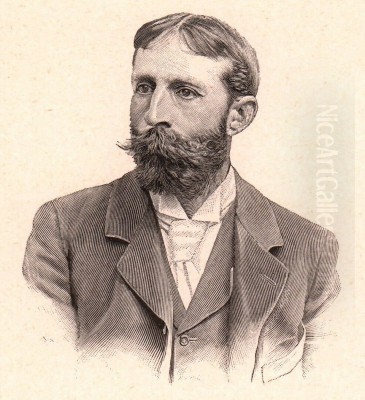
Edwin Lord Weeks stands as one of the most prominent American painters associated with the Orientalist movement of the late nineteenth century. Born into privilege but driven by an insatiable curiosity and a remarkable artistic talent, Weeks dedicated his career to capturing the vibrant life, intricate architecture, and dazzling light of lands far removed from his native New England. His meticulously detailed canvases transported viewers to the bustling markets of Morocco, the sacred sites of India, and the sun-drenched landscapes of Persia, establishing him as a leading figure among Western artists fascinated by the East. His life was one of extensive travel, rigorous artistic training, and prolific creation, leaving behind a legacy of works celebrated for their technical brilliance and ethnographic interest.
Early Life and Artistic Awakening in Boston
Edwin Lord Weeks was born in Boston, Massachusetts, in 1849. His family was affluent, involved in the lucrative spice and tea trade, which provided a comfortable upbringing and, crucially, the financial means to support his burgeoning artistic interests and extensive travel plans later in life. Unlike many aspiring artists of his time who faced familial opposition, Weeks's parents encouraged his creative pursuits. This support was foundational, allowing him the freedom to develop his skills and envision a life dedicated to art.
Evidence of his precocious talent emerged early. By the age of eighteen, in 1867, he had already produced works like Landscape with Blue Heron. This painting, created before his formal European training, already demonstrated a sophisticated understanding of composition and technique, suggesting either innate ability or early, perhaps local, instruction. It hinted at the keen observational skills and dedication to craft that would define his mature work. Boston, while a burgeoning cultural center, could not offer the advanced artistic training available in Europe, particularly for an artist drawn to the academic and realist traditions. The path forward inevitably led across the Atlantic.
Parisian Training: Honing Skills Under Masters
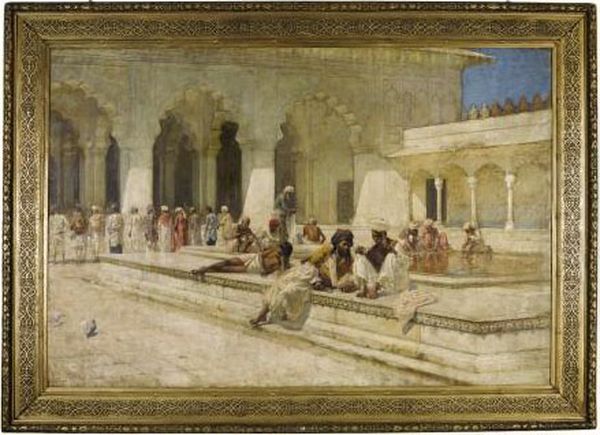
Seeking to refine his talents and immerse himself in the epicenter of the nineteenth-century art world, Weeks moved to Paris in 1872. This move was pivotal. He enrolled in the ateliers of two of the most respected and influential academic painters of the era: Léon Bonnat and Jean-Léon Gérôme. Studying under these masters provided Weeks with rigorous training in drawing, anatomy, composition, and the techniques of academic realism.
Léon Bonnat, known for his portraiture and historical paintings, emphasized strong draftsmanship and a sober realism. Jean-Léon Gérôme, himself a towering figure in the Orientalist genre, was perhaps an even more significant influence. Gérôme's own highly detailed, almost photographic depictions of historical scenes and life in North Africa and the Near East provided a direct model for Weeks. Gérôme's studio was a magnet for international students, including other Americans like Frederick Arthur Bridgman, who also became a noted Orientalist. The training under Gérôme undoubtedly solidified Weeks's interest in exotic subjects and equipped him with the technical precision needed to render them convincingly.
The Call of the East: Early Travels
While Paris provided the training, Weeks's true inspiration lay beyond Europe. Even before settling into his studies with Bonnat and Gérôme, he had begun his travels. An early trip took him to South America, demonstrating his adventurous spirit from the outset. However, it was the allure of the "Orient"—a term then used broadly to encompass North Africa, the Middle East, and parts of Asia—that truly captured his artistic imagination.
His initial forays into this world likely included trips to Egypt and Morocco. These regions were relatively accessible to European and American travelers and were already popular subjects for Orientalist painters like Gérôme, Eugène Fromentin, and Eugène Delacroix before him. These early journeys allowed Weeks to gather firsthand impressions, sketches, and artifacts that would fuel his paintings. He was captivated by the unfamiliar cultures, the intense quality of the light, the vibrant colors of local dress and architecture, and the dynamic energy of daily life.
Moroccan Sojourns: Capturing North African Life
Morocco became a recurring destination and a significant source of inspiration for Weeks throughout his career. He made several trips there, drawn to its bustling cities like Tangier and Salé, its ancient medinas, and its diverse population. His Moroccan paintings often depict crowded marketplaces, shaded courtyards, craftsmen at work, and scenes of public life. He excelled at capturing the interplay of brilliant sunlight and deep shadow, a characteristic feature of the North African environment.
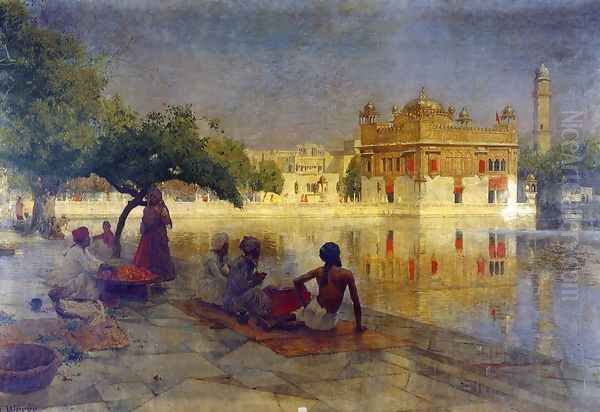
His works from this period showcase his developing ability to handle complex multi-figure compositions and render intricate architectural details, such as tiled walls, carved stucco, and wooden screens. He paid close attention to the textures of fabrics, the details of clothing, and the physiognomy of the people he depicted, aiming for a high degree of ethnographic accuracy, albeit viewed through a Western lens. These Moroccan scenes helped establish his reputation as an artist capable of bringing distant lands to life for audiences back home.
The Grand Journey: Persia and India
Weeks's most ambitious and arguably most defining travels took place in the 1880s and early 1890s, culminating in an extensive journey through Persia (modern-day Iran) and India. In 1892, he embarked on a particularly significant six-month expedition accompanied by the scholar and writer Theodore Child. Their journey took them overland from Trebizond on the Black Sea, through Persia, and deep into the Indian subcontinent. This arduous trip provided Weeks with an unparalleled wealth of material.
India, in particular, became a central focus of his later work. He traveled widely across the north, visiting cities like Agra, Delhi, Benares (Varanasi), Amritsar, Jodhpur, and Gwalior. He was fascinated by the subcontinent's diverse cultures, its complex religious life, and especially its magnificent architecture, from Mughal palaces and mosques to Hindu temples and bustling ghats along the Ganges. His Indian paintings are often considered the pinnacle of his achievement, characterized by their grand scale, luminous color, and meticulous detail.
This journey also resulted in one of Weeks's major written works. He documented their experiences and observations, illustrated with his own sketches and photographs, in the book From the Black Sea through Persia and India, published in 1895. Theodore Child also published his account, further disseminating knowledge and imagery from their travels.
Artistic Style: Realism, Light, and Detail
Edwin Lord Weeks's artistic style is firmly rooted in the academic realism he absorbed in Paris, particularly from Gérôme. His primary aim was to create convincing, detailed representations of the scenes he witnessed. He worked diligently from sketches, photographs (he was an avid photographer, using the camera as an essential tool for capturing detail), and artifacts collected during his travels. His studio in Paris was reportedly filled with exotic textiles, costumes, weapons, and architectural fragments that he used as props.
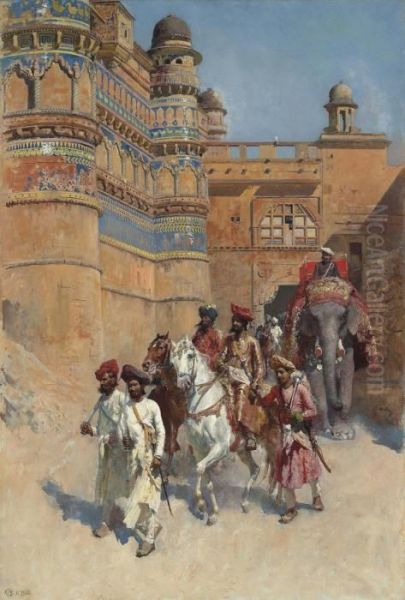
Perhaps the most celebrated aspect of his technique is his mastery of light and color. He excelled at depicting the intense, often harsh, sunlight of the regions he visited. His paintings frequently feature strong contrasts between brightly lit areas and deep shadows, effectively conveying the heat and atmosphere. He used a vibrant palette to capture the rich colors of clothing, market goods, and decorative tilework. His rendering of complex architectural elements—marble inlay, carved stone, intricate patterns—is remarkably precise.
While meticulous in detail, his brushwork could also be fluid and descriptive, particularly in rendering figures and suggesting movement. He populated his scenes with a wide array of individuals—merchants, worshippers, officials, travelers, laborers—often capturing moments of daily life, commerce, or ceremony. Unlike some Orientalists who leaned towards fantasy or sensuality, Weeks generally focused on observation and documentation, striving for accuracy in his depictions of places, people, and customs. His contemporaries included other skilled academic painters like William Bouguereau and history painters such as Jean-Paul Laurens, but Weeks carved his niche through his specific focus and travels.
Orientalism in Context
To understand Weeks's work fully, it's essential to place it within the broader context of nineteenth-century Orientalism. This artistic and cultural phenomenon involved the fascination of Western artists, writers, and scholars with the cultures of North Africa, the Middle East, and Asia. Driven by colonialism, trade, travel, and a romantic desire for the exotic, Orientalism produced a vast body of work depicting these regions.
Orientalist art varied widely, from the Romantic visions of Delacroix to the highly polished academicism of Gérôme and Weeks, and the ethnographic studies of artists like Osman Hamdi Bey (an Ottoman painter himself). While often visually stunning and informative, Orientalist art has also faced criticism in post-colonial studies for sometimes perpetuating stereotypes, presenting a romanticized or patronizing view of Eastern cultures, and framing the "Orient" as passive, unchanging, or decadent in contrast to a dynamic West.
Weeks's work, with its emphasis on detailed observation and specific locations, is generally considered among the more documentary forms of Orientalism. He depicted grand architecture and scenes of daily life with apparent fidelity. However, like all art of its time, it reflects the perspective and assumptions of a Western observer interacting with different cultures during an era of significant global power imbalances. His work remains valuable for its artistic merit and as a historical record of the places he visited, viewed through the lens of his time.
Major Works: Windows to Distant Worlds
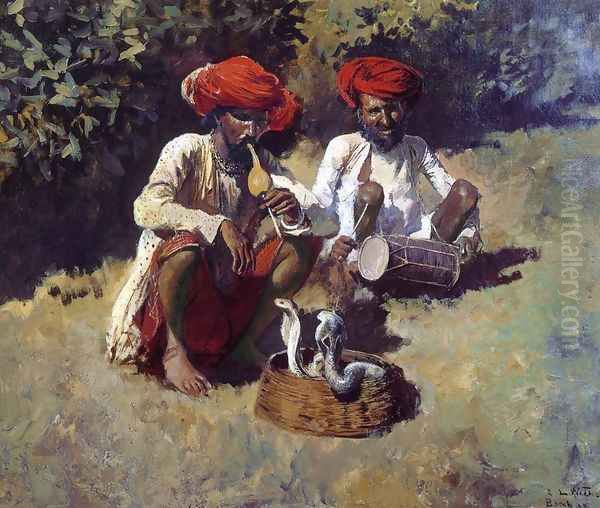
Edwin Lord Weeks produced a large body of work during his career. Several paintings stand out as particularly representative of his talent and thematic interests, especially those stemming from his Indian travels:
The Pearl Mosque, Agra (c. 1886-87): This work, depicting the exquisite seventeenth-century Moti Masjid within the Agra Fort, is a prime example of Weeks's skill in rendering complex architecture and brilliant light. He captures the gleaming white marble under the Indian sun, contrasting it with the shaded arcades and the figures gathered within. Variations of this subject, like Prayer Moment at the Puri Mosque (likely referring to a mosque within a specific Indian context, perhaps mislabeled or a different location), showcase similar interests.
The Golden Temple, Amritsar (c. 1890): A depiction of the Harmandir Sahib, the holiest shrine of Sikhism. Weeks masterfully conveys the reflection of the gilded temple in the surrounding sacred pool (sarovar), capturing the unique atmosphere of this important religious site.
Wedding Procession in Jodhpur: This painting exemplifies Weeks's ability to handle large, complex scenes filled with figures, animals (like elephants and camels), and architectural backdrops. It captures the pageantry and cultural richness of an Indian princely state ceremony.
The Banks of the River in Benares (c. 1882-83): Varanasi (Benares) and its ghats along the Ganges River were a powerful subject for Weeks. Works like Indians on the Ganges depict the intense spiritual and daily life activity along the river – pilgrims bathing, Brahmins praying, funeral pyres – set against the backdrop of temples and palaces.
The Fort of Gwalior, Madhya Pradesh: Showcasing another impressive example of Indian architecture, this work likely focuses on the imposing hilltop fortress, highlighting its scale and historical presence.
Other works, like the early Landscape with Blue Heron and watercolors such as Dawn in the Desert Oasis, demonstrate his versatility across different subjects and media, though his reputation rests firmly on his large-scale Orientalist oils. His contemporaries in America, like John Singer Sargent or James McNeill Whistler, pursued different stylistic paths, focusing more on portraiture or aestheticism, making Weeks's dedication to Orientalism quite distinct within the American context.
The Artist as Author and Explorer
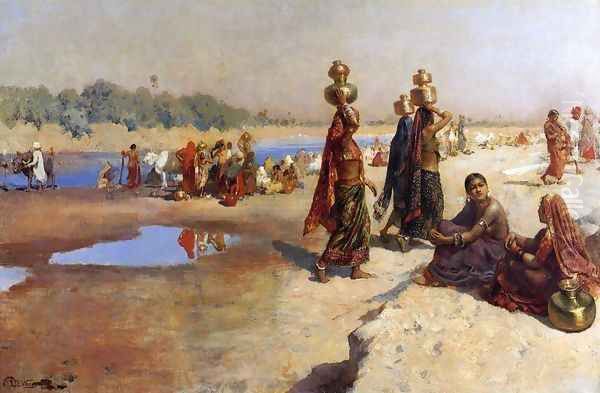
Weeks was more than just a painter; he was also a writer and an intrepid explorer. His travels often took him to regions that were difficult and sometimes dangerous for Westerners to access at the time. His commitment to firsthand observation meant enduring challenging conditions, navigating complex logistics, and immersing himself in unfamiliar environments.
His publications, From the Black Sea through Persia and India (1895) and the later Episodes of Mountaineering (1902), which detailed his climbing adventures, reveal another dimension of his character. These books provided detailed accounts of his journeys, illustrated with his own work, offering valuable insights into the places he visited and his experiences as a traveler. They complemented his paintings, providing narrative context and reinforcing his image as an artist deeply engaged with the world he depicted. His adventurous spirit set him apart from studio-bound academic painters and aligned him with other artist-travelers of the era.
Recognition, Legacy, and Influence
Edwin Lord Weeks achieved considerable success and recognition during his lifetime. He exhibited regularly at the prestigious Paris Salon, receiving medals and honors. His paintings were sought after by collectors in both France and the United States. His detailed, luminous, and exotic canvases appealed to the public's fascination with distant lands. In 1896, his contributions were recognized by the French government when he was made a Knight of the Legion of Honor, a significant accolade. His work was also featured in prominent publications like Harper's Magazine, further broadening his reach.
He is remembered today as one of the foremost American Orientalist painters, alongside figures like Frederick Arthur Bridgman. While the broader category of Orientalism is now viewed with more critical nuance, Weeks's technical skill, his mastery of light and architectural detail, and the sheer ambition of his travels remain impressive. His works provide a valuable, if specific, visual record of parts of the world undergoing significant change at the end of the nineteenth century.
His direct influence on subsequent generations of painters may be less pronounced than that of modernist figures who were emerging around the time of his death. However, his dedication to realism combined with exotic subject matter places him firmly within the lineage of academic painting, influenced by masters like Gérôme and Bonnat, and contemporary to other Orientalists such as the Austrian painters Ludwig Deutsch and Rudolf Ernst, the French Jean-Joseph Benjamin-Constant, and the Italian Alberto Pasini.
Final Years and Enduring Vision
Edwin Lord Weeks spent much of his adult life based in Paris, which served as his operational hub between his extensive travels. It was there that he maintained his studio, worked up his large canvases from his travel studies, and participated in the European art scene. His dedication to his craft and his adventurous life continued until his relatively early death.
Edwin Lord Weeks passed away in Paris in 1903, at the age of 54. He left behind a significant body of work that continues to fascinate viewers with its technical brilliance and its evocative portrayal of distant cultures and landscapes. He remains a key figure in the story of American art and the complex history of Orientalism, an artist whose life was as adventurous as his canvases were detailed and vibrant. His legacy is that of a bridge-builder, using his exceptional talent to connect Western audiences with the wider world as he saw it, captured in paint with remarkable skill and dedication.